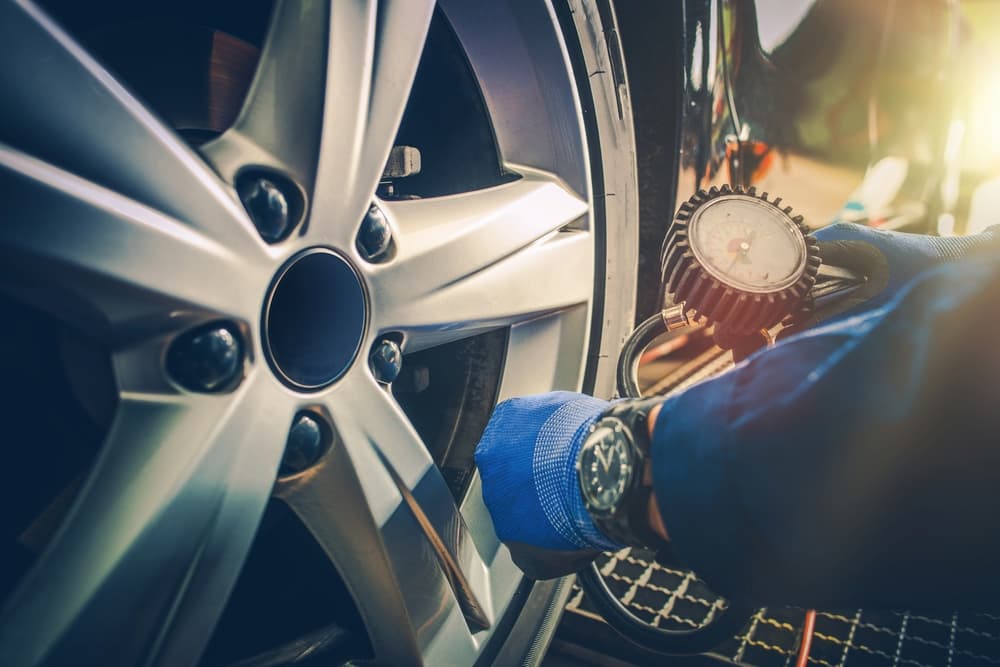How Do I Find the Correct Tire Pressure for My Car?

What You'll Learn
As you read this tire pressure guide, you'll learn:
- The recommended tire pressure varies by vehicle, so there's no one-size-fits-all answer to the question, "what should my tire pressure be?"
- Finding the appropriate tire pressure and maintaining it has numerous benefits ranging from safety to fuel efficiency.
- The right tire pressure for your car depends on your specific vehicle as well as the tires themselves. It's important to choose the right tires for your vehicle, then make sure you go by the vehicle's recommended tire pressure.
Why Correct Tire Pressure Matters
Relative to the wide world of car maintenance, checking your tire pressure is probably the easiest thing you can do for yourself. Still, many people overlook it because they don't know the importance of maintaining the right tire pressure. This article seeks to solve that problem, telling you everything you need to know about tire pressure.
For starters, it will be helpful to take a look at why tire pressure matters. This can generally be broken down into three primary reasons: safety, fuel economy, and tire life.
Safety
Considering the importance of safety while driving, this may be the single most important reason to familiarize with tire pressure and make sure you're keeping it at good levels. If your tires aren't properly inflated, they aren't achieving maximum traction, which means your stopping distance and handling won't be as good as they should be. Driving around with reduced handling capabilities becomes dangerous in the event that you need to react quickly to avoid a collision.
Furthermore, if your tires aren't inflated properly, there is an increased risk that they might blow out. This also applies to tire lifespan (more on that in a bit), but the cost of replacing a tire is nothing compared to the risk of getting into an accident. If a tire blows out while you're cornering or driving at hard speeds, it can be difficult to keep control of the vehicle.
Fuel Economy
When your tires are underinflated, they create more friction with the road than they should. This increase in resistance reduces fuel efficiency. One of the signs that your tires might be underinflated is that you've been getting worse gas mileage recently.
Tire Life
If your tires are overinflated, all of that pressure on the tire makes it wear out faster. Overinflated tires normally wear out faster in the center of the tread. Underinflated tires also wear out more quickly but in different ways. The insufficient pressure may cause the tire to lose tread segments or wear out on the sidewall. In either case, you'll get a lot more mileage out of your tires if you keep them inflated to the proper level.
How to Find the Correct Tire Pressure for My Vehicle
Now that you know how important it is to follow the recommended tire pressure, it's time to learn how to make that happen. There are two sources of recommendations that drivers must be aware of when it comes to recommended tire pressure: the vehicle and the tires themselves.
Tire Specifications
One of the biggest mistakes people make is filling their tires to the pressure on the tire's sidewall instead. This is the maximum pressure the tires should hold, not the recommendation. It's still important to know the maximum pressure your tires can hold so that you don't exceed it, but ideally, you really shouldn't even have to check. Assuming your tires were put on by a professional who knows what they're doing, your vehicle won't have tires that can't hold the appropriate pressure for your vehicle.
Of course, it can't hurt to be mindful of this number just in case. As long as you're not exceeding the pressure printed on the sidewall of your tire, though, the most important thing is to make sure you're going by the vehicle specifications instead.
Vehicle Specifications
Check the vehicle specs to make sure you have the right tire pressure. You can find the information you need on the decal inside the driver-side door. The recommended tire pressure has been listed in that location for most cars produced since 2003 (at which point it was inside the glove box, trunk lid, or fuel door. If you can't find or can't read the tire pressure recommendation on your car itself, look it up in the owner's manual or online.
There are a few more things to keep in mind when adjusting your tire pressure:
- It's advisable to measure tire pressure when your vehicle has been parked for a few hours, or preferably overnight. This is how you get the most accurate reading. After you've finished a long drive and your tires are warm from friction with the road, they'll give you a reading that's too high because the heat makes air expand.
- Some vehicles specify different tire pressure levels for the front and rear tires, so make sure you know if that applies to your vehicle.
- Some vehicles (especially trucks and SUVs) will have different recommended tire pressures depending on the load or the way the vehicle is used. If you have doubts about the best tire pressure for your vehicle, don't hesitate to do further research or ask an expert for some guidance.
Chevy Tire Service in Phoenix
Valley Chevy Dealers are experts in all things Chevrolet. That means you can find your nearest dealership whenever you need tire service, such as tire rotation, tire replacement, or just a checkup to confirm that everything is in good shape. If you have questions about anything in the meantime or want to confirm that you're filling your tires appropriately, don't hesitate to reach out to us about that either.
FAQ Section
Since the recommended tire pressure is specific to your vehicle and sometimes even your driving habits, it's normally best to ask questions in person. That way, the person you're talking to can take everything into account. With that being said, there are a few common answers to some of the most common tire pressure questions we get, including the following.
How do I know if my tire pressure is low?
There are a few ways to go about checking your tire pressure. If your vehicle is relatively new, it probably has a tire pressure monitoring system (TPMS). This device takes your tire pressure automatically every time your vehicle is running, and it will alert you if you need to make an adjustment. If you have one of these (and it's working), you shouldn't have to check your tire pressure manually except for maybe as you're filling them.
If you don't have a TPMS or don't trust it, check your tire pressure the old-fashioned way. You can do a manual check with a tire pressure gauge, which is relatively easy to find and inexpensive to purchase. Most basic vehicle care kits include one.
How often should you check tire pressure?
It's typically a good idea to check your vehicle's tire pressure once a month. When the weather changes significantly, it's good to check again because the air temperature outside affects the tire pressure.
Featured Image: Virrage Images/Shutterstock
